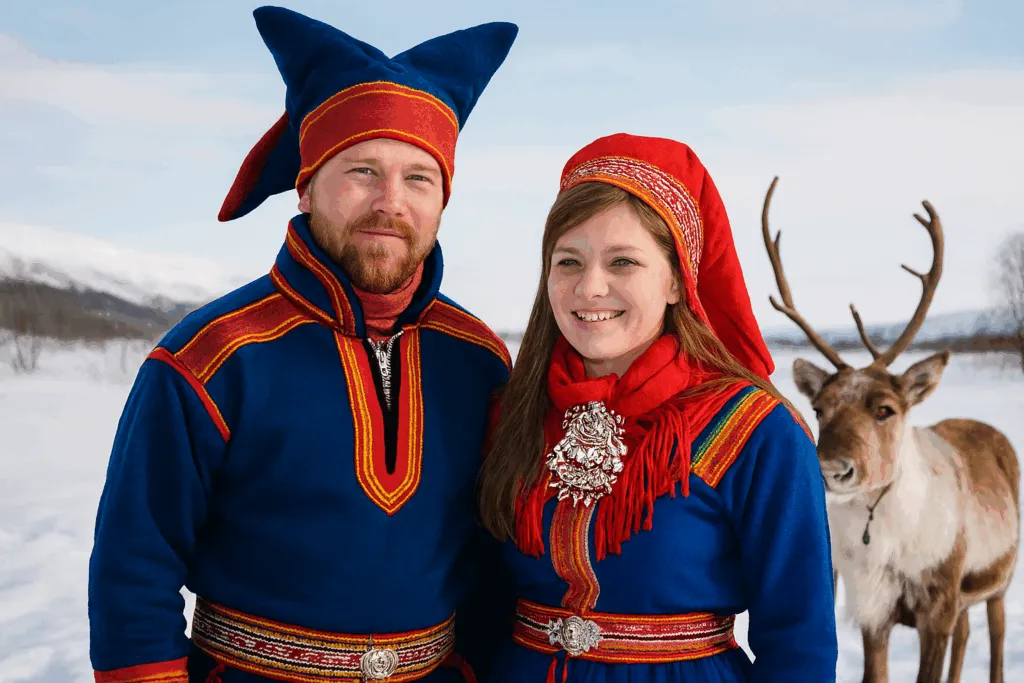The Sámi are the indigenous people of Sápmi, a region spanning northern parts of Norway, Sweden, Finland, and Russia’s Kola Peninsula. Numbering between 80,000 and 100,000 today, roughly half live in Norway, about 20 % in Sweden, 12 % in Finland, and less than 5 % in Russia. While many Sámi now reside in urban centers, significant communities persist in remote Arctic and sub-Arctic areas.
Sámi languages form a branch of the Uralic language family, sharing roots with Finnish and Hungarian. There are ten main Sámi languages, from Northern Sámi—spoken by the majority—to Akkala and Kemi Sámi, which are nearly extinct. These languages fall into Western, Eastern, and Southern groups, none of which are mutually intelligible. Only about one-quarter of Sámi speak a Sámi language as their first language, while the others use state languages, though bilingual policies are gradually gaining ground.
Traditionally, Sámi society was semi-nomadic and based on reindeer herding. Reindeer provide meat, fur, transport, and hold sacred importance. Today about 10 % of Sámi—mostly in Norway and Sweden—continue professional reindeer husbandry. Fishing, berry-picking, hunting, and crafting with wood, leather, and felt have also been critical livelihoods.
Social organization revolved around the siida, a clan or territorial community of several families managing common grazing lands, hunting zones, and fisheries. Collective decision-making within the siida ensured equitable distribution of resources and resilience against the harsh climate.
Prior to widespread Christianization, the Sámi practiced shamanism. Noaidis (shamans) used decorated drums and joik—a unique form of chant—to commune with spirits of mountains, forests, waters, and ancestors. Today, shamanic traditions survive in revitalized forms and feature prominently in cultural festivals alongside contemporary musical expressions.
During the 19th and 20th centuries, Sámi underwent assimilation: Sámi languages were banned in schools, ancestral lands were appropriated for agriculture and hydroelectric projects, and missionaries aimed to eradicate indigenous beliefs. From the late 20th century onward, a cultural renaissance took hold. Sámi parliaments were established in Norway (1989), Sweden (1993), and Finland (1996), and domestic laws began to recognize indigenous rights and fund language and cultural preservation.
Political bodies secured consultative rights on development projects affecting traditional Sami territories, fisheries, and reindeer routes. Local hearings now include Sámi councils, which assert protections against mining and dam construction. In Russia, the Sámi rights movement is nascent but growing, focusing on official recognition and educational support.
Contemporary Sámi culture shines through colorful gákti—traditional costumes made of bright wool and leather adorned with geometric and floral patterns—and joik singing, which captures the essence of landscapes, animals, and individuals without instrumental accompaniment. Since 1986, February 6 has been celebrated as International Sámi Day, featuring handicraft exhibitions, concerts, and conferences.
Modern Sámi youth harness digital media to document their history and folklore, producing films, books, and blogs in Sámi languages. Ecotourism initiatives allow visitors to stay in traditional lavvu tents, experience reindeer herding, and learn sustainable land use practices. These ventures help curb youth outmigration and bolster the economies of remote Sámi communities.
Despite centuries of external pressures, Sápmi remains the ancestral homeland of the Sámi, whose ongoing cultural revival continues to enrich the Arctic and sub-Arctic landscapes they have inhabited for millennia.
- BMW: traveling in the footsteps of a legendary brand
- Indonesia
- A quick look at Lucknow: one day in the Uttar Pradesh capital
- Mongolia
- Bolivia
- With a Movie Camera in Kamchatka
- Turtle facts
- Istanbulkart Scams: What Tourists Should Watch Out For
- Colombia
- Haiti, unfiltered: how to travel smart and fall in love with the country
- Chukchi
- Dagestan: between the grandeur of nature and the challenges of tourism
- Georgia
- The Crocodile Chase: An Unlikely Friendship Born in Africa
- Distant Storms Create Dangerous Surf at East Coast Beaches
- Finland
- Pirate treasure hunting around the world: where to look without breaking the law
- Nicaragua
- Lifehacks for buying airline tickets
- Glorious sea — sacred Baikal











